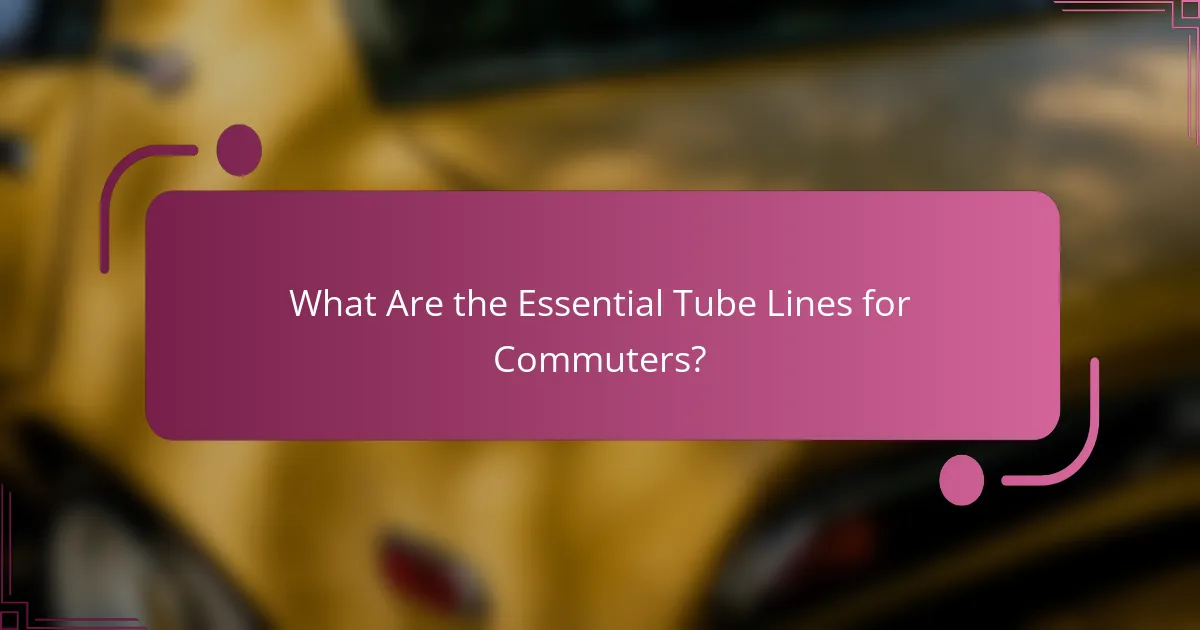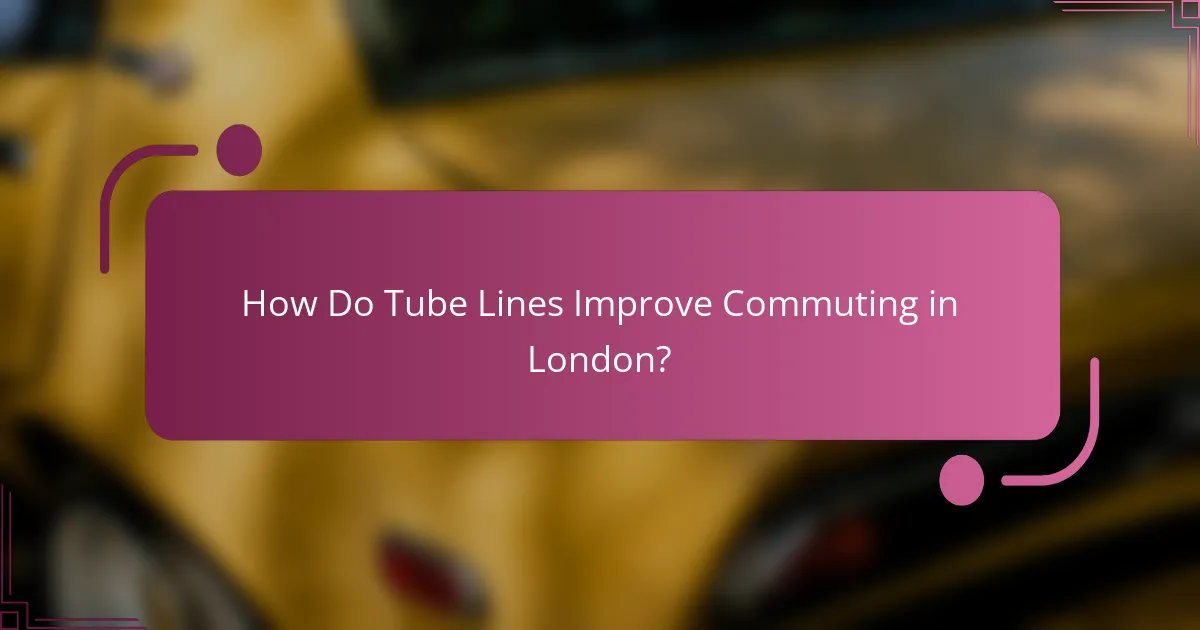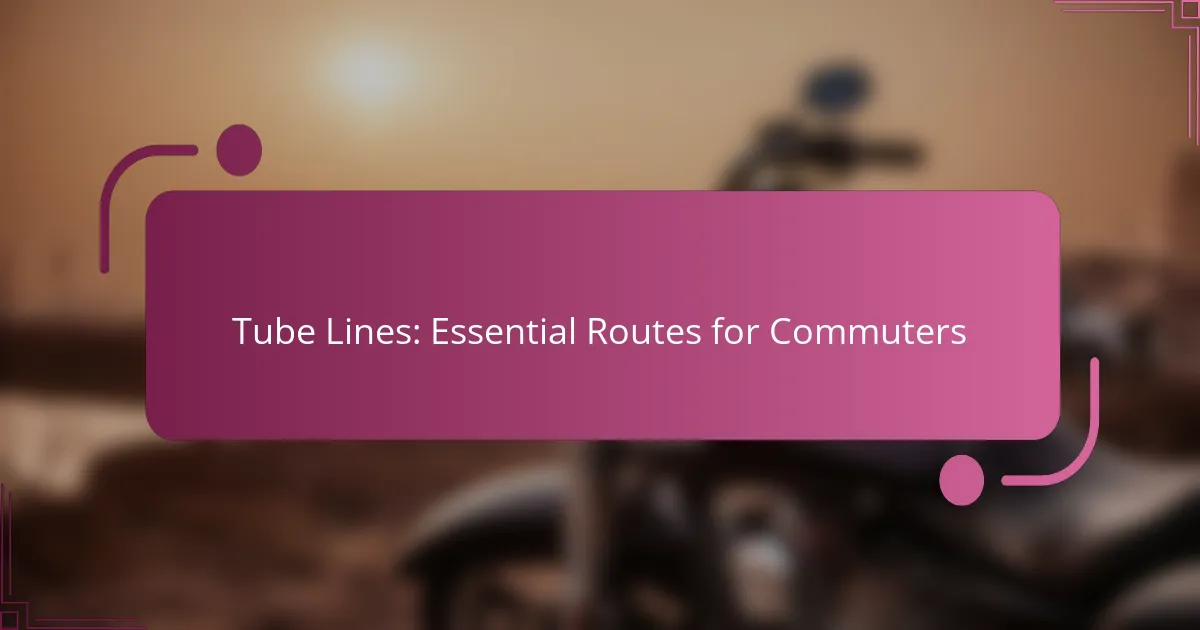The Tube lines in London, including the Central, District, Piccadilly, Jubilee, and Victoria lines, are essential for commuters seeking efficient travel across the city. These lines not only provide vital connections but also help alleviate road congestion, making them a convenient alternative for millions of daily travelers. By understanding the unique features of each line, commuters can optimize their journeys and navigate the city with ease.

What Are the Essential Tube Lines for Commuters?
The essential Tube lines for commuters in London include the Central, District, Piccadilly, Jubilee, and Victoria lines. These lines provide vital connections across the city, facilitating efficient travel for daily commuters.
Central Line
The Central Line is one of the busiest lines in the London Underground network, running from West Ruislip to Epping. It serves key areas such as Oxford Circus and Liverpool Street, making it crucial for commuters heading to central business districts.
Trains on the Central Line run frequently, typically every 2-5 minutes during peak hours. Commuters should be aware that the line can experience delays, especially during rush hour, so planning ahead is advisable.
District Line
The District Line operates from Upminster to Wimbledon and serves a variety of neighborhoods, including Kensington and Richmond. It is particularly useful for commuters traveling to the West End and other cultural hubs.
With services running every 5-10 minutes during peak times, the District Line offers reliable access to major attractions. However, some branches may have less frequent service, so checking the schedule is recommended.
Piccadilly Line
The Piccadilly Line connects Heathrow Airport to central London, making it essential for both local commuters and international travelers. Key stops include Piccadilly Circus and Covent Garden, popular destinations for work and leisure.
Trains generally run every 5-8 minutes during peak hours, providing a convenient option for airport transfers. Commuters should note that some sections may be subject to planned maintenance, so checking for service updates is wise.
Jubilee Line
The Jubilee Line runs from Stanmore to Stratford, linking important areas like Canary Wharf and London Bridge. This line is vital for those working in finance and technology sectors, providing quick access to major business hubs.
With trains operating every 2-7 minutes during peak times, the Jubilee Line is known for its efficiency. However, it can become crowded, especially during rush hours, so travelers should be prepared for busy conditions.
Victoria Line
The Victoria Line stretches from Walthamstow to Brixton, serving key locations such as Victoria Station and Oxford Circus. It is a popular choice for commuters due to its speed and direct routes across central London.
Trains run every 2-5 minutes during peak hours, making it one of the most reliable lines. Commuters should be mindful of potential delays during maintenance work, particularly on weekends, and plan their journeys accordingly.

How Do Tube Lines Improve Commuting in London?
Tube lines significantly enhance commuting in London by providing efficient, reliable, and fast travel options across the city. They reduce congestion on roads and offer a convenient alternative for millions of daily commuters.
Reduced Travel Times
Tube lines are designed to minimize travel times, often allowing commuters to reach their destinations in a fraction of the time it would take by car or bus. For example, a journey that might take 30 minutes by road could be reduced to 15 minutes on the Tube, especially during peak hours when traffic congestion is common.
To maximize efficiency, commuters should plan their routes using the Tube map and consider off-peak travel when possible. This can further decrease travel times and enhance the overall commuting experience.
Increased Accessibility
The Tube network improves accessibility by connecting various neighborhoods, business districts, and key landmarks throughout London. Stations are strategically located to ensure that most residents are within a short walk to a Tube stop, making it easier for everyone to access essential services and employment opportunities.
Additionally, many Tube stations are equipped with facilities for individuals with reduced mobility, including lifts and ramps. Commuters should check the Transport for London (TfL) website for specific accessibility information for each station.
Enhanced Connectivity
Tube lines enhance connectivity by linking with other transport services, such as buses, trains, and the Docklands Light Railway (DLR). This integration allows commuters to transfer seamlessly between different modes of transport, facilitating easier journeys across the city.
For effective travel planning, commuters can use the TfL journey planner, which provides real-time updates and route options, ensuring they can navigate the network efficiently. Understanding the connections between various lines can significantly improve overall travel convenience.

What Are the Key Features of Each Tube Line?
The Tube lines in London each have distinct features that cater to various commuter needs, including key stops, frequency, and connectivity. Understanding these features can help commuters choose the best routes for their journeys.
Central Line – Key Stops
The Central Line runs from West Ruislip to Liverpool Street, covering major areas such as Oxford Circus, Holborn, and Bank. It is known for its high frequency, with trains typically arriving every 2-3 minutes during peak hours.
Commuters should note that the Central Line offers excellent connections to other lines, making it a vital route for those traveling across central London. Key interchanges include Tottenham Court Road and Stratford, which link to multiple other lines.
District Line – Key Stops
The District Line stretches from Upminster to Wimbledon, serving key locations like Westminster, Tower Hill, and Earls Court. This line is particularly useful for accessing attractions such as the Houses of Parliament and the Tower of London.
Frequency on the District Line varies, with trains running approximately every 5-7 minutes during peak times. Commuters should be aware of potential delays, especially during weekends when maintenance work is common.
Piccadilly Line – Key Stops
The Piccadilly Line connects Heathrow Airport to Cockfosters, passing through important stops like Piccadilly Circus, Leicester Square, and Covent Garden. This line is essential for travelers heading to and from the airport, providing a direct link to central London.
Trains on the Piccadilly Line typically arrive every 5 minutes during peak hours. Commuters should plan for potential delays during late evenings and weekends due to scheduled maintenance or service changes.

What Is the Tube Line Frequency During Peak Hours?
During peak hours, Tube lines in London typically operate with increased frequency to accommodate the high volume of commuters. Most lines run every 2 to 5 minutes, ensuring that passengers can access public transport efficiently during busy times.
Central Line Frequency
The Central Line generally operates with a frequency of every 2 to 3 minutes during peak hours. This line is a major artery for commuters traveling through central London, connecting key areas such as Oxford Circus and Liverpool Street.
To maximize convenience, it’s advisable to check live updates on the Transport for London (TfL) website or app, as service frequency can vary slightly based on demand and operational considerations.
District Line Frequency
During peak hours, the District Line runs approximately every 3 to 5 minutes. This line serves a wide range of destinations, from Upminster to Wimbledon, making it essential for many commuters.
Keep in mind that some branches of the District Line may have different frequencies, so it’s beneficial to verify specific routes if you’re traveling to less common destinations.
Piccadilly Line Frequency
The Piccadilly Line operates every 3 to 5 minutes during peak times, providing crucial access to areas like Heathrow Airport and central London. This frequency helps ensure that travelers can reach their destinations without significant delays.
For those relying on the Piccadilly Line, consider checking the TfL service status for any disruptions, especially during major events or maintenance work that could affect service frequency.

How Do Tube Lines Impact Local Businesses?
Tube lines significantly influence local businesses by increasing customer access and enhancing visibility. The presence of a tube station can lead to higher foot traffic and improved convenience for shoppers, which often translates into increased sales for nearby establishments.
Increased Foot Traffic
Tube lines generate substantial foot traffic, as commuters often pass through areas surrounding stations. This influx can boost sales for local shops, cafes, and restaurants, especially during peak commuting hours.
For example, businesses located within a few hundred meters of a tube station may see a traffic increase of 20-30% compared to those further away. Establishments that capitalize on this traffic, such as by offering quick service or promotional deals, can maximize their revenue potential.
Accessibility for Customers
Accessibility is a key advantage of tube lines, as they provide easy transport options for customers. Businesses located near tube stations can attract a diverse customer base, including those who may not have otherwise visited the area.
To enhance accessibility, local businesses should consider signage that directs commuters to their locations. Additionally, offering services like online ordering with in-store pickup can cater to busy commuters looking for convenience.

What Are the Ticketing Options for Tube Lines?
Commuters using Tube lines in London have several ticketing options, including pay-as-you-go methods and travel passes. The most popular choices are the Oyster Card and contactless payment methods, which offer convenience and savings compared to traditional paper tickets.
Oyster Card Benefits
The Oyster Card is a smart card that provides significant savings on travel across London’s Tube network. Users benefit from lower fares compared to single paper tickets, making it an economical choice for regular commuters.
Additionally, the Oyster Card allows for seamless travel across various transport modes, including buses and trains. It can be topped up easily online or at stations, ensuring that commuters can always access funds for their journeys.
Commuters should also consider the daily cap feature of the Oyster Card, which limits the maximum amount spent in a day. This can lead to substantial savings for those who travel frequently, as once the cap is reached, further travel within that day is free.
